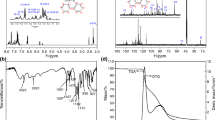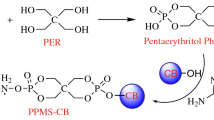Abstract
Phosphorus-containing organic–inorganic hybrid flame retardant with core–shell structure (Salen-PZN-Cu@Ni-Mof) was prepared. Thermogravimetric analysis (TGA) showed that when the additive amount was only 3wt%, the introduction of Salen-PZN-Cu@Ni-Mof significantly improved the thermal stability of epoxy resin (EP) composites. The results of the cone calorimeter test showed that adding 3wt% Salen-PZN-Cu@Ni-Mof made the peak of heat release rate (PHRR), total heat release (THR), smoke production rate (SPR) and total smoke production (TSP) of epoxy resin composites reduced by 30.4%, 10.8%, 29.5% and 6.8%, respectively. It was proved that Salen-PZN-Cu@Ni-Mof could significantly enhance the fire safety of epoxy resin composites, which was attributed to the synergetic combination of the flame retardant effect of the phosphazene structure itself, the catalyzed carbon formation of various metal ions and the porous mof materials with strong adsorption properties. Besides, it was found that the Ni-Mof could strengthen the compatibility between the flame retardant and the EP matrix effectively through the tensile test. The novel core–shell structure flame retardant Salen-PZN-Cu@Ni-Mof promised to be a functional filler that integrated features of flame retardancy and high ductility.












Similar content being viewed by others
References
He WT, Song P, Yu B, Fang Z, Wang H (2020) Flame retardant polymeric nanocomposites through the combination of nanomaterials and conventional flame retardants. Prog Mater Sci 114:100687
Seidi F, Movahedifar E, Naderi G, Akbari V, Ducos F, Shamsi R, Vahabi H, Saeb MR (2020) Flame Retardant Polypropylenes: A Review. Polymers 12(8):1701
Dasari A, Yu ZZ, Cai GP (2013) Recent developments in the fire retardancy of polymeric materials[J]. Prog Polym Sci 38(9):1357–1387
Cheheltani R, Ezzibdeh RM, Chhour P, Kim J, Jurcova M, Hsu JC, Blundell C, Litt HI, Ferrari VA, Allcock HR, Sehgal CM, Cormode DP (2016) Tunable, biodegradable gold nanoparticles as contrast agents for computed tomography and photoacoustic imaging. Biomaterials 102:87–97
Fushimi T, Allcock HR (2009) Cyclotriphosphazenes with sulfur-containing side groups: refractive index and optical dispersion. Dalton Trans 14:2477–2481
Fushimi T, Allcock HR (2010) Synthesis and optical properties of sulfur-containing monomers and cyclomatrix polyphosphazenes. Dalton Trans 39(22):5349–5355
Tataroğlu A, Özen F, Koran K, Dere A, Görgülü AO, Al-Senany N, Al-Ghamdi A, Farooq WA, Yakuphanoglu F (2018) Structural, electrical and photoresponse properties of Si-based diode with organic interfacial layer containing novel cyclotriphosphazene compound. SILICON 10(3):683–691
Koran K (2018) Structural, chemical and electrical characterization of organocyclotriphosphazene derivatives and their graphene-based composites. J Mol Struct 1179:224–232
Yang ZJ, Zhang W, Wang T, Li JD (2014) Improved thiophene solution selectivity by Cu2+, Pb2+ and Mn2+ ions in pervaporative poly[bis(p-methyl phenyl) phosphazene]desulfurization membrane. J Membrane Sci 454:463–469
Yang ZJ, Zhang WY, Li JD, Chen JX (2012) Polyphosphazene membrane for desulfurization: Selecting poly[bis(trifluoroethoxy) phosphazene] for pervaporative removal of thiophene. Sep Purif Technol 93:15–24
Fei ST, Wood RM, Lee DK, Stone DA, Chang HL, Allcock HR (2008) Inorganic-Organic Hybrid Polymers with Pendent Sulfonated Cyclic Phosphazene Side Groups as Potential Proton Conductive Materials for Direct Methanol Fuel Cells. J Membrane Sci 320(1):206–214
Liu W, Zheng YL, Li J, Liu L, Huang XB, Zhang JW, Kang XQ, Tang XZ (2012) Novel polyurethane networks based on hybrid inorganic/organic phosphazene-containing nanotubes with surface active hydroxyl groups. Polym Advan Technol 23(1):1–7
Ding JH, Wang L, Yu HJ, Yang Q, Deng LB (2008) Progress in Synthesis of Polyphosphazenes. Des Monomers Polym 11(3):215–222
Qian LJ, Ye LJ, Qiu Y, Qu SR (2011) Thermal degradation behavior of the compound containing phosphaphenanthrene and phosphazene groups and its flame retardant mechanism on epoxy resin. Polymer 52(24):5486–5493
Tao K, Li J, Xu L, Zhao XL, Xue LX, Fan XY, Yan Q (2011) A novel phosphazene cyclomatrix network polymer: Design, synthesis and application in flame retardant polylactide. Polym Degrad Stabil 96(7):1248–1254
Zhou X, Qiu SL, Xing WY, Gangireddy CSR, Gui Z, Hu Y (2017) Hierarchical Polyphosphazene@Molybdenum Disulfide Hybrid Structure for Enhancing the Flame Retardancy and Mechanical Property of Epoxy Resins. ACS Appl Mater Inter 9(34):29147–29156
Qiu SL, Xing WY, Mu XW, Feng XM, Ma C, Yuen RK, Hu Y (2016) A 3D Nanostructure Based on Transition-Metal Phosphide Decorated Heteroatom-Doped Mesoporous Nanospheres Interconnected with Graphene: Synthesis and Applications. ACS Appl Mater Inter 8(47):32528–32540
Heydari-Bafrooei E, Amini M, Ardakani MH (2016) An electrochemical aptasensor based on TiO2/MWCNT and a novel synthesized Schiff base nanocomposite for the ultrasensitive detection of thrombin. Biosens Bioelectro 85:828–836
Feng XR, Li D, Han JD, Zhuang XL, Ding JX (2017) Schiff base bond-linked polysaccharide-doxorubicin conjugate for upregulated cancer therapy. Mat Sci Eng C 76:1121–1128
Jeevadason AW, Murugavel KK, Neelakantan MA (2014) Review on Schiff bases and their metal complexes as organic photovoltaic materials. Renew Sust Energ Rev 36:220–227
Manjunatha KB, Rajarao R, Umesh G, Bhat BR, Poornesh P (2017) All-optical switching and limiting properties of a Ru (II) Schiff-base complex for nonlinear optical applications. Laser Phys 27(8):85401
Rhodes J, Chen H, Hall SR, Beesley JE, Jenkins DC, Collins P, Zheng B (1995) Therapeutic potentiation of the immune system by costimulatory Schiff-base-forming drugs. Nature 377(6544):71–75
Su HY, Zhang W, Wu YY, Han XD, Liu G, Jia QM, Shan XY (2018) Schiff base-containing dextran nanogel as pH-sensitive drug delivery system of doxorubicin: Synthesis and characterization. J Biomater Appl 33:088532821878396
Seifzadeh D, Valizadeh-Pashabeigh V, Bezaatpour A (2016) 5-CM-Salophen schiff base as an effective inhibitor for corrosion of mild steel in 0.5 M HCl. Chem Eng Commun 203(10):1279–1287
El-Lateef HMA, Ismael M, Mohamed IMA (2015) Novel Schiff base amino acid as corrosion inhibitors for carbon steel in CO2-saturated 3.5% NaCl solution: experimental and computational study. Corros Rev 33:77–97
Naik A, Bourbigot S, Bellayer S, Touati N, Tayeb KB, Vezin H, Fontaine G (2018) Salen complexes as fire protective agents for thermoplastic polyurethane: Deep electron paramagnetic resonance spectroscopy investigation. ACS Appl Mater Inter 10(29):24860–24875
Wei WC, Deng C, Huang SC, Wei YX, Wang YZ (2018) Nickel-Schiff base decorated graphene for simultaneously enhancing the electroconductivity, fire resistance, and mechanical properties of a polyurethane elastomer. J Mater Chem 6(18):8643–8654
Ramgobin A, Fontaine G, Penverne C, Bourbigot S (2017) Thermal stability and fire properties of salen and metallosalens as fire retardants in thermoplastic polyurethane (TPU). Materials 10(6):665
Xu GJ, Meng ZS, Guo XJ, Zhu HW, Deng KM, Xiao CY, Liu YZ (2019) Molecular simulations on CO2 adsorption and adsorptive separation in fullerene impregnated MOF-177, MOF-180 and MOF-200. Comp Mater Sci 168:58–64
Ha NT, Lefedova OV, Ha NN (2016) Theoretical study on the adsorption of carbon dioxide on individual and alkali-metal doped MOF-5s. Russ J Phys Chem A+ 90(1):220–225
Kadioglu O, Keskin S (2018) Efficient separation of helium from methane using MOF membranes. Sep Purif Technol 191:192–199
Ke F, Qiu LG, Yuan YP, Jiang X, Zhu JF (2012) Fe3O4@MOF core–shell magnetic microspheres with a designable metal–organic framework shell. J Mater Chem 22(19):9497–9500
Lee J, Farha OK, Roberts J, Scheidt KA, Nguyen ST, Hupp JT (2009) Metal–organic framework materials as catalysts. Chem Soc Rev 38(5):1450–1459
Hou YB, Liu LX, Qiu SL, Zhou X, Gui Z, Hu Y (2018) DOPO-modified two-dimensional co-based metal-organic framework: Preparation and application for enhancing fire safety of poly(lactic acid). ACS Appl Mater Inter 10(9):8274–8286
Cui JF, Zhang YB, Wang LR, Liu H, Wang NN, Yang BP, Guo JH, Tian L (2020) Phosphorus-containing Salen-Ni metal complexes enhancing the flame retardancy and smoke suppression of epoxy resin composites. J Appl Polym Sci 137(21):48734
Hou YB, Hu WZ, Gui Z, Hu Y (2017) Preparation of metal-organic frameworks and their application as flame retardants for polystyrene. Ind Eng Chem Res 56:8
Sun XJ, Wu TT, Yan ZM, ChenWJ LXB, Xia QB, Chen SY, Wu QH (2019) Novel MOF-5 derived porous carbons as excellent adsorption materials for n-hexane. J Solid State Chem 271:354–360
Zhao L, Zhao CX, Guo CY, Li YT, Li SL, Sun LY, Li H, Xiang D (2019) Polybenzoxazine resins with polyphosphazene microspheres: synthesis, flame retardancy, mechanisms, and applications. ACS Omega 4(23):20275–20284
Naik AD, Fontaine G, Bellayer S, Bourbigot S (2015) Crossing the traditional boundaries:salen-based Schiff bases for thermal protective applications. ACS Appl Mater Inter 7(38):21208–21217
Acknowledgements
We appreciate the support of the National Nature Science Foundation of China (No. 51465036) and the Development of Science and Technology of Gansu Province(20YF3FA003).
Author information
Authors and Affiliations
Corresponding authors
Ethics declarations
Conflict of interest
The authors declare that they have no known competing financial interests.
Additional information
Publisher's Note
Springer Nature remains neutral with regard to jurisdictional claims in published maps and institutional affiliations.
Supplementary Information
Below is the link to the electronic supplementary material.
Rights and permissions
About this article
Cite this article
He, T., Guo, J., Qi, C. et al. Core–shell structure flame retardant Salen-PZN-Cu@Ni-Mof microspheres enhancing fire safety of epoxy resin through the synergistic effect. J Polym Res 29, 27 (2022). https://doi.org/10.1007/s10965-021-02831-4
Received:
Accepted:
Published:
DOI: https://doi.org/10.1007/s10965-021-02831-4




